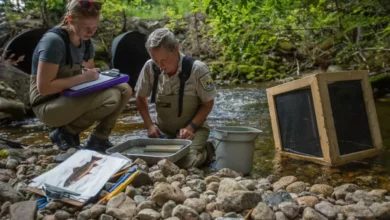The Bayonne Peninsula Maritime History


 The Bayonne Peninsula, to the north of Staten Island at the junction of Newark Bay, Kill Van Kull, and Arthur Kill, experienced a restricted amount of large scale waterfront development due to shallow water surrounding the area.
The Bayonne Peninsula, to the north of Staten Island at the junction of Newark Bay, Kill Van Kull, and Arthur Kill, experienced a restricted amount of large scale waterfront development due to shallow water surrounding the area.
Development was concentrated on the Kill Van Kull until navigation improvements in the early twentieth century opened Newark Bay to larger vessels.
Due to its central location, the Bayonne peninsula benefited from increasing maritime traffic and was eventually transformed from a rural destination of wealthy New Yorkers in the nineteenth century to an urban industrial center in the twentieth century.
Inland navigation improvements in 1825-1835, along with rail connections, including the Elizabeth-Somerville (later the Central Railroad of New Jersey), were responsible for an increase in vessel traffic in the early nineteenth century.
Such traffic carried coal from Pennsylvania, clay products from New Jersey, and manufactured goods from the surrounding area, and soon made cities like Jersey City and Elizabethtown into new industrial centers.
In 1864, the Central Railroad of New Jersey opened the railroad bridge across Newark Bay and enabled coal to reach Jersey City via Bayonne.

 Rail links through Bayonne resulted in its incorporation as a town in 1861 and as a city in 1864. The Port Johnson terminal, at which was transshipped large amounts of coal, was the first sizeable industrial development and set the stage for Bayonne’s rapid growth as a center of industry.
Rail links through Bayonne resulted in its incorporation as a town in 1861 and as a city in 1864. The Port Johnson terminal, at which was transshipped large amounts of coal, was the first sizeable industrial development and set the stage for Bayonne’s rapid growth as a center of industry.
By 1875, the population growth of New York had increased the demand for kerosene used for lighting. Petroleum companies, seeking more inexpensive and larger areas than could be had in Brooklyn and Queens, soon relocated to the peninsula.
Standard Oil completed the first long distance pipeline to Bayonne from oil fields in Texas, and Bayonne became a national center of petroleum refining. By the end of the nineteenth century, industrial activity had filled most of the Bayonne peninsula to somewhere east of Port Johnson.
Concurrent with the rise in demand for gasoline to power automobiles and generate electricity, production switched from kerosene to gasoline. This increasing demand resulted in the construction of new and bigger plants.
This second wave of industrial expansion extended to 1917. By this time, most of the marsh lands had been filled in.

 Maritime traffic began to diminish after World War One, and many waterfront industries disappeared during the Great Depression.
Maritime traffic began to diminish after World War One, and many waterfront industries disappeared during the Great Depression.
Today, petroleum refining continues to form a large sector of the local economy, but not to the extent of the early twentieth century.
This essay is excerpted with minor editing for clarification from Target Investigations in Connection with the New York and New Jersey harbor Navigation Project, May 2004, prepared for the U.S. Army Corps of Engineers, New York District, by Andrew D.W. Lydecker and Stephen R. James, Jr. of Panamerican Consultants, Inc.
Illustrations, from above; Aerial view of industrial waterfront, Bayonne, New Jersey; View of Bayonne, 1974 with decaying remains of a dock at Port Johnston Terminal visible in the left foreground (by Hope Alexander, National Archives); and a view of Manhattan from Bayonne, 1974, by Hope Alexander (National Archives).
Source link





